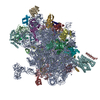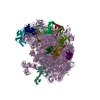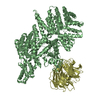+ データを開く
データを開く
- 基本情報
基本情報
| 登録情報 | データベース: EMDB / ID: EMD-3213 | |||||||||
|---|---|---|---|---|---|---|---|---|---|---|
| タイトル | Architecture of human mTOR Complex 1 - 5.9 Angstrom reconstruction | |||||||||
 マップデータ マップデータ | Human mTOR complex 1 | |||||||||
 試料 試料 |
| |||||||||
 キーワード キーワード | Rapamycin / TOR / mTOR / Raptor / mLST8 / FKBP / mTORC1 | |||||||||
| 機能・相同性 |  機能・相同性情報 機能・相同性情報RNA polymerase III type 2 promoter sequence-specific DNA binding / RNA polymerase III type 1 promoter sequence-specific DNA binding / positive regulation of cytoplasmic translational initiation / regulation of locomotor rhythm / T-helper 1 cell lineage commitment / positive regulation of pentose-phosphate shunt / positive regulation of wound healing, spreading of epidermal cells / TORC2 signaling / TORC2 complex / regulation of membrane permeability ...RNA polymerase III type 2 promoter sequence-specific DNA binding / RNA polymerase III type 1 promoter sequence-specific DNA binding / positive regulation of cytoplasmic translational initiation / regulation of locomotor rhythm / T-helper 1 cell lineage commitment / positive regulation of pentose-phosphate shunt / positive regulation of wound healing, spreading of epidermal cells / TORC2 signaling / TORC2 complex / regulation of membrane permeability / cellular response to leucine starvation / negative regulation of lysosome organization / heart valve morphogenesis / TFIIIC-class transcription factor complex binding / TORC1 complex / voluntary musculoskeletal movement / positive regulation of transcription of nucleolar large rRNA by RNA polymerase I / calcineurin-NFAT signaling cascade / positive regulation of odontoblast differentiation / regulation of osteoclast differentiation / RNA polymerase III type 3 promoter sequence-specific DNA binding / positive regulation of keratinocyte migration / regulation of lysosome organization / MTOR signalling / Amino acids regulate mTORC1 / cellular response to nutrient / energy reserve metabolic process / cellular response to L-leucine / regulation of autophagosome assembly / Energy dependent regulation of mTOR by LKB1-AMPK / TORC1 signaling / ruffle organization / serine/threonine protein kinase complex / cellular response to methionine / negative regulation of cell size / positive regulation of osteoclast differentiation / positive regulation of ubiquitin-dependent protein catabolic process / inositol hexakisphosphate binding / cellular response to osmotic stress / anoikis / negative regulation of protein localization to nucleus / cardiac muscle cell development / negative regulation of calcineurin-NFAT signaling cascade / regulation of myelination / positive regulation of transcription by RNA polymerase III / negative regulation of macroautophagy / Macroautophagy / positive regulation of myotube differentiation / regulation of cell size / positive regulation of actin filament polymerization / Constitutive Signaling by AKT1 E17K in Cancer / germ cell development / TOR signaling / behavioral response to pain / mTORC1-mediated signalling / oligodendrocyte differentiation / positive regulation of oligodendrocyte differentiation / positive regulation of translational initiation / protein kinase activator activity / social behavior / protein serine/threonine kinase inhibitor activity / CD28 dependent PI3K/Akt signaling / positive regulation of TOR signaling / HSF1-dependent transactivation / regulation of macroautophagy / enzyme-substrate adaptor activity / positive regulation of G1/S transition of mitotic cell cycle / response to amino acid / 'de novo' pyrimidine nucleobase biosynthetic process / positive regulation of epithelial to mesenchymal transition / heart morphogenesis / vascular endothelial cell response to laminar fluid shear stress / neuronal action potential / positive regulation of lipid biosynthetic process / cellular response to nutrient levels / regulation of cellular response to heat / positive regulation of lamellipodium assembly / cardiac muscle contraction / phagocytic vesicle / T cell costimulation / positive regulation of stress fiber assembly / positive regulation of endothelial cell proliferation / 14-3-3 protein binding / cytoskeleton organization / endomembrane system / negative regulation of autophagy / negative regulation of insulin receptor signaling pathway / cellular response to amino acid starvation / cellular response to starvation / positive regulation of glycolytic process / positive regulation of translation / protein serine/threonine kinase activator activity / regulation of signal transduction by p53 class mediator / Regulation of PTEN gene transcription / VEGFR2 mediated vascular permeability / post-embryonic development / TP53 Regulates Metabolic Genes / regulation of actin cytoskeleton organization / phosphoprotein binding / cellular response to amino acid stimulus 類似検索 - 分子機能 | |||||||||
| 生物種 |  Homo sapiens (ヒト) Homo sapiens (ヒト) | |||||||||
| 手法 | 単粒子再構成法 / クライオ電子顕微鏡法 / 解像度: 5.9 Å | |||||||||
 データ登録者 データ登録者 | Aylett CHS / Sauer E / Imseng S / Boehringer D / Hall MN / Ban N / Maier T | |||||||||
 引用 引用 |  ジャーナル: Science / 年: 2016 ジャーナル: Science / 年: 2016タイトル: Architecture of human mTOR complex 1. 著者: Christopher H S Aylett / Evelyn Sauer / Stefan Imseng / Daniel Boehringer / Michael N Hall / Nenad Ban / Timm Maier /  要旨: Target of rapamycin (TOR), a conserved protein kinase and central controller of cell growth, functions in two structurally and functionally distinct complexes: TORC1 and TORC2. Dysregulation of ...Target of rapamycin (TOR), a conserved protein kinase and central controller of cell growth, functions in two structurally and functionally distinct complexes: TORC1 and TORC2. Dysregulation of mammalian TOR (mTOR) signaling is implicated in pathologies that include diabetes, cancer, and neurodegeneration. We resolved the architecture of human mTORC1 (mTOR with subunits Raptor and mLST8) bound to FK506 binding protein (FKBP)-rapamycin, by combining cryo-electron microscopy at 5.9 angstrom resolution with crystallographic studies of Chaetomium thermophilum Raptor at 4.3 angstrom resolution. The structure explains how FKBP-rapamycin and architectural elements of mTORC1 limit access to the recessed active site. Consistent with a role in substrate recognition and delivery, the conserved amino-terminal domain of Raptor is juxtaposed to the kinase active site. | |||||||||
| 履歴 |
|
- 構造の表示
構造の表示
| ムービー |
 ムービービューア ムービービューア |
|---|---|
| 構造ビューア | EMマップ:  SurfView SurfView Molmil Molmil Jmol/JSmol Jmol/JSmol |
| 添付画像 |
- ダウンロードとリンク
ダウンロードとリンク
-EMDBアーカイブ
| マップデータ |  emd_3213.map.gz emd_3213.map.gz | 58.6 MB |  EMDBマップデータ形式 EMDBマップデータ形式 | |
|---|---|---|---|---|
| ヘッダ (付随情報) |  emd-3213-v30.xml emd-3213-v30.xml emd-3213.xml emd-3213.xml | 12.3 KB 12.3 KB | 表示 表示 |  EMDBヘッダ EMDBヘッダ |
| 画像 |  EMD-3213_mTORC1.png EMD-3213_mTORC1.png | 98.3 KB | ||
| アーカイブディレクトリ |  http://ftp.pdbj.org/pub/emdb/structures/EMD-3213 http://ftp.pdbj.org/pub/emdb/structures/EMD-3213 ftp://ftp.pdbj.org/pub/emdb/structures/EMD-3213 ftp://ftp.pdbj.org/pub/emdb/structures/EMD-3213 | HTTPS FTP |
-検証レポート
| 文書・要旨 |  emd_3213_validation.pdf.gz emd_3213_validation.pdf.gz | 230.3 KB | 表示 |  EMDB検証レポート EMDB検証レポート |
|---|---|---|---|---|
| 文書・詳細版 |  emd_3213_full_validation.pdf.gz emd_3213_full_validation.pdf.gz | 229.4 KB | 表示 | |
| XML形式データ |  emd_3213_validation.xml.gz emd_3213_validation.xml.gz | 6 KB | 表示 | |
| アーカイブディレクトリ |  https://ftp.pdbj.org/pub/emdb/validation_reports/EMD-3213 https://ftp.pdbj.org/pub/emdb/validation_reports/EMD-3213 ftp://ftp.pdbj.org/pub/emdb/validation_reports/EMD-3213 ftp://ftp.pdbj.org/pub/emdb/validation_reports/EMD-3213 | HTTPS FTP |
-関連構造データ
- リンク
リンク
| EMDBのページ |  EMDB (EBI/PDBe) / EMDB (EBI/PDBe) /  EMDataResource EMDataResource |
|---|---|
| 「今月の分子」の関連する項目 |
- マップ
マップ
| ファイル |  ダウンロード / ファイル: emd_3213.map.gz / 形式: CCP4 / 大きさ: 62.5 MB / タイプ: IMAGE STORED AS FLOATING POINT NUMBER (4 BYTES) ダウンロード / ファイル: emd_3213.map.gz / 形式: CCP4 / 大きさ: 62.5 MB / タイプ: IMAGE STORED AS FLOATING POINT NUMBER (4 BYTES) | ||||||||||||||||||||||||||||||||||||||||||||||||||||||||||||
|---|---|---|---|---|---|---|---|---|---|---|---|---|---|---|---|---|---|---|---|---|---|---|---|---|---|---|---|---|---|---|---|---|---|---|---|---|---|---|---|---|---|---|---|---|---|---|---|---|---|---|---|---|---|---|---|---|---|---|---|---|---|
| 注釈 | Human mTOR complex 1 | ||||||||||||||||||||||||||||||||||||||||||||||||||||||||||||
| 投影像・断面図 | 画像のコントロール
画像は Spider により作成 | ||||||||||||||||||||||||||||||||||||||||||||||||||||||||||||
| ボクセルのサイズ | X=Y=Z: 1.39 Å | ||||||||||||||||||||||||||||||||||||||||||||||||||||||||||||
| 密度 |
| ||||||||||||||||||||||||||||||||||||||||||||||||||||||||||||
| 対称性 | 空間群: 1 | ||||||||||||||||||||||||||||||||||||||||||||||||||||||||||||
| 詳細 | EMDB XML:
CCP4マップ ヘッダ情報:
| ||||||||||||||||||||||||||||||||||||||||||||||||||||||||||||
-添付データ
- 試料の構成要素
試料の構成要素
-全体 : Human mTOR complex 1
| 全体 | 名称: Human mTOR complex 1 |
|---|---|
| 要素 |
|
-超分子 #1000: Human mTOR complex 1
| 超分子 | 名称: Human mTOR complex 1 / タイプ: sample / ID: 1000 / 集合状態: tetrameric / Number unique components: 3 |
|---|---|
| 分子量 | 理論値: 1 MDa |
-分子 #1: mTOR
| 分子 | 名称: mTOR / タイプ: protein_or_peptide / ID: 1 / 集合状態: Dimeric / 組換発現: Yes |
|---|---|
| 由来(天然) | 生物種:  Homo sapiens (ヒト) / 別称: Human Homo sapiens (ヒト) / 別称: Human |
| 分子量 | 理論値: 290 KDa |
| 組換発現 | 生物種:  組換細胞: 21 / 組換プラスミド: Multibac |
| 配列 | UniProtKB: Serine/threonine-protein kinase mTOR |
-分子 #2: Raptor
| 分子 | 名称: Raptor / タイプ: protein_or_peptide / ID: 2 / 集合状態: Dimeric / 組換発現: Yes |
|---|---|
| 由来(天然) | 生物種:  Homo sapiens (ヒト) / 別称: Human Homo sapiens (ヒト) / 別称: Human |
| 分子量 | 理論値: 150 KDa |
| 組換発現 | 生物種:  組換細胞: 21 / 組換プラスミド: Multibac |
| 配列 | UniProtKB: Regulatory-associated protein of mTOR |
-分子 #3: mLST8
| 分子 | 名称: mLST8 / タイプ: protein_or_peptide / ID: 3 / 組換発現: Yes |
|---|---|
| 由来(天然) | 生物種:  Homo sapiens (ヒト) / 別称: Human Homo sapiens (ヒト) / 別称: Human |
| 分子量 | 理論値: 40 KDa |
| 組換発現 | 生物種:  組換細胞: 21 / 組換プラスミド: Multibac |
| 配列 | UniProtKB: Target of rapamycin complex subunit LST8 |
-実験情報
-構造解析
| 手法 | クライオ電子顕微鏡法 |
|---|---|
 解析 解析 | 単粒子再構成法 |
| 試料の集合状態 | particle |
- 試料調製
試料調製
| 緩衝液 | pH: 8 / 詳細: 100 mM NaCl, 10 mM NaBicine, 1 mM TCEP |
|---|---|
| グリッド | 詳細: Quantifoil R2/2 with an additional thin carbon layer |
| 凍結 | 凍結剤: ETHANE / チャンバー内湿度: 100 % / チャンバー内温度: 120 K / 装置: FEI VITROBOT MARK I / 手法: 4 second blotting |
- 電子顕微鏡法
電子顕微鏡法
| 顕微鏡 | FEI TITAN KRIOS |
|---|---|
| 温度 | 平均: 100 K |
| アライメント法 | Legacy - 非点収差: Objective lens astigmatism was corrected at 150,000 times magnification |
| 日付 | 2015年5月5日 |
| 撮影 | カテゴリ: CCD フィルム・検出器のモデル: FEI FALCON II (4k x 4k) 実像数: 6299 / 平均電子線量: 25 e/Å2 詳細: Single movie frame readout. 7 frames per exposure. Drift corrected in post-processing. 4 images per hole. ビット/ピクセル: 16 |
| 電子線 | 加速電圧: 300 kV / 電子線源:  FIELD EMISSION GUN FIELD EMISSION GUN |
| 電子光学系 | 倍率(補正後): 100719 / 照射モード: FLOOD BEAM / 撮影モード: BRIGHT FIELD / Cs: 2.7 mm / 最大 デフォーカス(公称値): 4.0 µm / 最小 デフォーカス(公称値): 1.9 µm / 倍率(公称値): 59000 |
| 試料ステージ | 試料ホルダーモデル: FEI TITAN KRIOS AUTOGRID HOLDER |
| 実験機器 |  モデル: Titan Krios / 画像提供: FEI Company |
- 画像解析
画像解析
| 詳細 | Poor quality micrographs were rejected by eye, based on the extent and regularity of the Thon rings observed in the contrast transfer function. Estimation of the contrast transfer function was carried out for each image using CTFFIND3, particles were selected semi-automatically using boxer and batchboxer. |
|---|---|
| CTF補正 | 詳細: Each image |
| 最終 再構成 | 想定した対称性 - 点群: C2 (2回回転対称) / アルゴリズム: OTHER / 解像度のタイプ: BY AUTHOR / 解像度: 5.9 Å / 解像度の算出法: OTHER / ソフトウェア - 名称: CTFFIND3, RELION, 1.3 詳細: For full details see the supplemental materials and methods in the accompanying publication which provides processing details and the classification schema. 使用した粒子像数: 309792 |
 ムービー
ムービー コントローラー
コントローラー



























 Z (Sec.)
Z (Sec.) Y (Row.)
Y (Row.) X (Col.)
X (Col.)






















